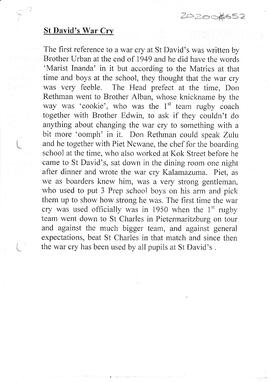Área de identidad
Código de referencia
Título
Fecha(s)
- 30 July 2009 (Creación)
Nivel de descripción
Unidad documental simple
Volumen y soporte
1 A4 printed page
Área de contexto
Nombre del productor
Historia biográfica
Institución archivística
Historia archivística
Historical Collection
Origen del ingreso o transferencia
Historical Collection
Área de contenido y estructura
Alcance y contenido
From the desk of the Senior Deputy Headmaster
On Monday, 27 January, St David's Marist Inanda marks 73 years since the School officially opened
its gates: 73 years of history. In 1941, while WW 2 was raging across the globe, Marist Inanda was
established by the Marist Brothers on its current premises . The School in 1941 would have been
surrounded by grasslands, by veld, and located a fair distance from any significant urban
settlement – Rosebank would probably have been the nearest shops – a considerable walk on dirt
roads: certainly no tarred Rivonia Road. The area to the North and North East of the School, where
Sandton City is today, was predominantly fruit orchards and small holdings - how different the
environment in which the School now operates.
A little bit of History
The Marist blazer, the blue and gold striped blazer, was first introduced at St Charles College in
Pietermaritzburg, then a Marist School, in 1927. In 1933, all the Marist Schools in South Africa
adopted the blue and gold striped blazer as official uniform, no different to what St David's boys
wear today. Throughout the world, thousands of pupils wear the same blazer with passion and
pride - Marist is the common bond of pupils at hundreds of schools worldwide. The pocket of the
blazer has an 'A' and 'M' intertwined, standing for "Ave Maria", Latin for Hail Mary – this also
appears on the St David's badge.
The first reference to a war cry at St David's was written by Brother Urban at the end of 1949. The
first war cry included the words "Marist Inanda", but according to the Matrics of 1949, it was a
feeble war cry. The Head Prefect of 1949, Don Rethman, approached the first team rugby coaches,
Brother Alban and Brother Edwin, and asked permission for changing the war cry to something
with a bit more "oomph", something more lively and dynamic. Permission was granted and the
Head Prefect, who could speak Zulu, together with the School's Chef, Piet Ncwane, who had moved
to St David's from Marist Koch Street (the first school in Johannesburg), sat down in the dining
room one night after dinner and wrote the War Cry – the Kalamazumba: the one St David's boys still
sing/chant. By the way, our current library is the old dining room and besides his cooking and
song-writing skills, the School Chef, Mr Ncwane, who co-wrote the war cry, was by all accounts an
immensely powerful gentleman, who was reputed to be able to pick up three prep boys sitting on
his one arm!
The Kalamazumba was officially used for the first time in 1950 when the 1st XV played against St
Charles College in Pietermaritzburg. St David's, the underdogs on that day, against expectations,
beat St Charles. Much credit for the victory was given to the new war cry and, since that historic
match in 1950, the Kalamazumba has been used at all fixtures by the boys of St David's Marist
Inanda.
Valorización, destrucción y programación
Acumulaciones
Sistema de arreglo
A27 with a printed copy and content in this entry
Área de condiciones de acceso y uso
Condiciones de acceso
Copyright St David's Marist Inanda
Condiciones
Copyright St David's Marist Inanda
Idioma del material
Escritura del material
Notas sobre las lenguas y escrituras
Características físicas y requisitos técnicos
Instrumentos de descripción
Área de materiales relacionados
Existencia y localización de originales
Existencia y localización de copias
Unidades de descripción relacionadas
Área de notas
Identificador/es alternativo(os)
Puntos de acceso
Puntos de acceso por materia
Puntos de acceso por lugar
Puntos de acceso por autoridad
- Castle, W J (Materia)
- Brother Edwin (Materia)
- Ncwane, Piet (Materia)
- Rethman, D (Materia)


